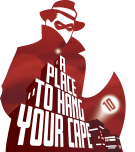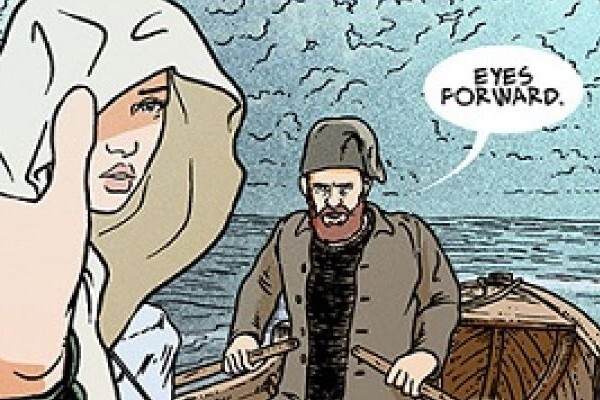The Isle of the Dead #1, written by Dillon Michael Fields and drawn by Diego Guerra, is appropriately based on a painting. This makes sense with the vagueness of the plot. The visuals flow in and around this short comic, filling in the spaces between the words. The plot is very minimal, of a young woman who just lost her husband. She then goes on a journey to an island with his coffin, most likely accompanying him to his final resting place. However, the reader is never told what exactly occurs. Not much seems to happen over the course of this issue; the widow simply travels through this strange island, guided by men who appear to be priests.
The compelling art style, rendered in color, has a muted palette. Guerra has an interesting sense of perspective, drawing the characters at many different angles. The only vibrancy comes at the beginning, right before the widow leaves her town of the living for the island. This shift in style visually signifies that the isle exists in a separate world. It works very well. Most of this comic is allegorical, with an emphasis on visual storytelling. The ferryman that requests payment before the widow can cross to the island resembles Charon – the boatman of the dead in Greek mythology.
A hydra emerges from the water at one point. It looms near a ship that seems to be connected to her husband. Also according to Greek mythology, the Lernaean Hydra guarded an entrance to the underworld. The priests do not let her look back or stray from the path. For most of the issue, people carry the coffin of her husband right behind her. This resembles Orpheus’s journey from the underworld. However, in the end, the widow cannot pass into the church. This suggests that the isle of the dead itself is a boundary space between life and death. She cannot yet cross because her time of death has not yet come.
While this method of allegory enriches the story and works well for the most part, it sometimes gets too abstract to follow. People without much knowledge of mythology might have a hard time with the references. Having a little more background might be useful. The author or artist do not define the time period either; it seems to be the 19th or perhaps early 20th century. This has no bearing on the plot, affording a sense of timelessness to it. Death is perhaps the one universal constant across all of humanity; regardless of age, status or health. This must be why we have so many stories about death and the afterlife.
Every culture invents their own ideas of death, in an effort to find understanding. We cannot know what happens when we die, despite how much we wish to. Death is the last and greatest mystery. Despite the widow’s wish to hold onto her husband, they no longer exist in the same world. Though many have tried, attempting to bridge the gap between the living and the dead always has consequences. The Isle of the Dead tells us through the widow that we must move on. Death is inevitable, and our curiosity about it will be answered in time.
Did you find any other references to the afterlife that we missed? Have contemplations on the meaning of life and death? Fascinated by Greek mythology? If you said yes to any of the above questions then you’re in luck because The Isle of the Dead #1 is available through LinkTree. Let us know in the comments of any of your thoughts on life, death, and all things Isle of the Dead. You can also hit us up on Facebook or Twitter!

